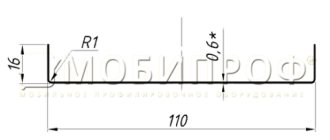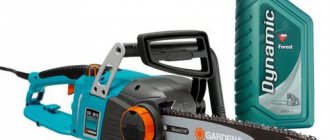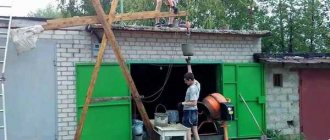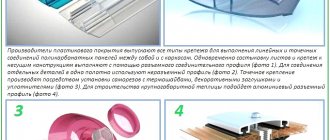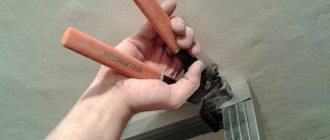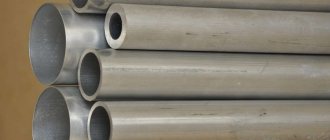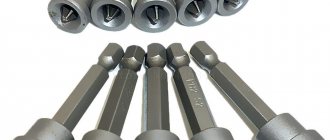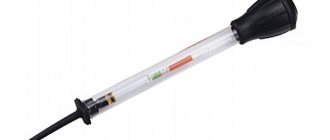One of the most popular finishing options is covering surfaces using sheet materials. Where a metal profile is required, which is used to form a high-strength frame.
When forming the frame, various materials can be used: wooden beams, plastic pipes. However, professionals prefer metal profiles, since compared to other building materials they are distinguished by high reliability, long service life, ease of installation and universal design.
pros
RECOMMENDED ON THE TOPIC
- Types of wrenches
- Types of sliding gates
Why are metal profiles so popular? This is due to their positive technical and operational characteristics, which include:
- Resistance to sudden temperature changes and high air humidity;
- High strength and reliability - these parameters are due to the presence of stiffeners in metal profiles and sufficient thickness of the metal;
- Corrosion resistance. Most models have a protective, anti-corrosion coating (a layer of zinc or polymer coating), which allows them to retain their original appearance for a long time even in conditions of high humidity;
- Environmental friendliness of this building material. Do not emit harmful chemicals into the atmosphere;
- Easy to install. To use metal profiles in repair and construction work, you do not need to purchase expensive tools. Cutting or bending is carried out using standard devices: metal scissors, grinders, hacksaws;
- Long service life. If installed correctly, metal profiles can serve you for a long time;
- A unique combination of price and quality. Their low cost makes them stand out in the building materials market. The use of metal profiles in repair and construction work will not greatly affect the final budget and will not entail unexpected material costs.
Is it possible to adjust the sizes
Factories produce standard product lengths of 3-4 meters. However, in creating an even partition or wall with figured elements, different lengths of the product are needed. To do this, the metal elements are either extended or cut to the length required for the structure.
Profile cutting methods:
- Scissors for cutting metal. You can cut the product evenly only along the marked lines. The disadvantage is the slightly curved edges after cutting. The cut strip is placed on a flat surface and leveled by tapping with a hammer.
- A hacksaw is not a very convenient method. There are small shavings from cutting the product. However, the cut will be smooth.
- Bulgarian. When working with an electrical appliance, sparks fly in all directions.
Craftsmen do not recommend cutting the profile with a grinder - the protective layer on the edges of the cut metal strip is damaged. As a result, the edges may become covered with rust.
Cutting machine. A large electrical appliance used in large rooms with large volumes of work.
You can cut the profile without any problems using Soviet-made scissors.
Elongation of a metal element. In order to increase the product, 2 methods are used:
- The use of an extension cord is a durable metal part coated with a protective layer against corrosion. It is applied to the edges of two planks and fixed with self-tapping screws.
- Homemade extension cord from the PN guide. It is necessary to cut 10 cm from the product and attach it to the edges of the profiles. Fixation is done with self-tapping screws.
It is easy to adjust the length of the metal frame element. You just need to make accurate measurements and marks. You should not lose sight of millimeters, as they can play an important role in the evenness of the structure.
Profiles for creating a frame structure on the wall have certain dimensions and material thickness. They are coated with an anti-corrosion agent (galvanized) - moisture does not affect metal products. Before purchasing profiles, you need to know their number from the measured dimensions of the room.
Types of metal profiles
Today, there is a wide selection of metal profiles on the market; they can be used to produce structures of various sizes and configurations. Below is a table of main sizes:
| Name | Size | Metal thickness |
| U-shaped | 50x22x20 mm, 65x22x20 mm, 80x22x20 mm, 100x22x20 mm | 1.2 mm |
| L-shaped | 40x40 mm, 50x50 mm, 44x60 mm | 1.2 mm |
| Z-shaped | 40x22x20 mm, 30x22x20 mm, 50x22x20 mm | 1.2 mm, 1.5 mm |
| T-shaped | 65x30 mm, 80x30 mm | 1.2 mm |
The metal has high technological properties, which allows it to be used without restrictions in the construction of a wide variety of structures (even under the negative influence of environmental factors).
Which metal profile is more in demand?
Selecting a metal profile for a gypsum plasterboard frame
What is it Types Manufacturers How to choose
Rare renovations inside an apartment are completed without drywall. With its help, you can bring to life various design ideas from interior partitions and arches to multi-level ceilings. All these structures are mounted on a lightweight, durable metal frame made of profiles. It is difficult for someone who is faced with this task for the first time to immediately understand the variety of their types. We will tell you what sizes and types of profiles there are for drywall, and for what purposes it can be used.
Applying profiles
For finishing, experts recommend using the following types of metal profiles:
Guides (square profiles) - as a basis for fastening ceiling and rack profiles, with the length of a single section being 3 or 4 meters;
Ceiling (T-shaped profiles) - used to form lathing, which serves as a fastener for various finishing materials. These products have cross-sectional parameters of 60*27 millimeters;
Rack (U-shaped profiles) - a frame made of metal rack profiles for load-bearing structures and walls. These types of profiles are attached to guides on the ceiling, floor or walls;
Corner profiles - to strengthen corners when puttingtying drywall;
Beacon profiles - used to create a more even surface of brick or concrete walls by applying plaster.
Corner
The corner profile has an L-shaped section. Its shelves come with the same or different lengths. They are called equal-flange and unequal-flange corner profiles. Products are made by hot rolling or bending sheet steel. Corners are used as elements subject to axial loads - tension and compression. To obtain a combined section, you can connect several corners together.
The parameters of metal corners are regulated by state standards:
- GOST 8509-93 - equal-flange hot-rolled profile;
- GOST 8510-93 - unequal flange hot-smooth profile;
- GOST 19771-93 - equal flange bent profile;
- GOST 19772-93 - unequal bent profile.
Available with shelf widths from 20 to 250 mm. They are used to strengthen window and door openings during masonry, for the manufacture of wickets, gates, in the construction of stairs, etc.
Accessories
As experts note, creating a steel frame is simply impossible without the use of special components. These include:
- Internal corner connectors;
- Longitudinal connectors;
- Cross connectors.
To secure the metal profile for drywall, use self-tapping screws or screws with anchors. Thus, the most reliable fixation of the connection is achieved.
As for siding, it is worth noting that attaching siding to a metal profile is the most durable cladding option, especially when compared with a similar structure on a wooden sheathing.
Additional accessories for fixing drywall.
In order to assemble the sheathing, you will need auxiliary parts:
- Two-level connector for CD profile. This part is sold in an unfolded, flat form and before starting work it needs to be bent in the shape of the letter P. It is used to connect rack-mount parts perpendicular to each other.
- Single-level connector for CD profile or “Crab”. They connect perpendicular CD profiles in exactly the same way. If the load is more than 20 kilograms, then you will need two self-tapping screws for fastening. Otherwise, the seals are simply bent.
- Direct suspension for a rack (supporting) profile. This is a bracket, the standard length of which is 12.5 cm. It looks like a strip of aluminum or galvanized steel with holes. Withstands loads up to 40 kilograms. It is attached to the wall with two dowel nails, then the edges are bent and the frame parts are already attached to them.
- Anchor suspension for ceiling carriers. Often called suspension with traction. Replaces the part described above if it is not long enough. Used on horizontal surfaces, for ceilings, for example.
- Extension. Needed to connect two carriers to each other. It has tubercles on the sides, this indicates where the profile joins. There are also two holes for screwing in self-tapping screws.
- Corner connector. It connects elements that do not form a cross. You can do without a connector. Cut the flanges of the profile that needs to be connected so that a tongue is formed, and screw it in place with self-tapping screws.
Aluminum profiles
Nowadays suspended ceilings are used for finishing residential and office premises. They are distinguished by a wide variety of models, ease of installation and a very attractive price. Baguettes for this kind of ceiling structures are made mainly from aluminum, since this material is resistant to high pressure, which is formed due to the tension of the PVC film.
Profiles for tiles are also created from aluminum; such products play a decorative role in finishing. Aluminum baguettes for suspended ceilings are presented in several modifications:
- Wall moldings - canvases are attached at a considerable distance from the floor slabs (from five centimeters);
- Ceiling baguettes - canvases are fixed on load-bearing slabs, if insufficiently strong material was used when finishing the walls (unable to withstand high tension);
- Universal baguettes - can be fixed to the ceiling or walls;
- Structural baguettes - with the help of this product, multi-level stretch ceilings or single steps and ledges are created;
- Connecting baguettes - used to fasten individual panels to each other.
How to calculate the quantity?
To calculate the required number of parts of the PN profile, you must use the following formula: K = P/D
In this formula, K means quantity, P is the perimeter of the room, and D is the length of one element.
Let's look at an example. With a room perimeter of 14 m (the walls are 4 m and 3 m, respectively) and the length of the selected profile is 3 m, we obtain:
K = 14/3 = 4.7 pieces.
Rounding up, we get 5 PN profiles
To calculate the number of PP profiles for a simple sheathing, you should use several formulas:
- L1 = H*D, where L1 is the number of linear meters of PP, H is the number of elements depending on the step, D is the length of the room;
- L2 = K*W, where L2 is the length of the transverse PP profiles, K is their number, W is the width of the room;
- L = (L1+L2) /E, where E is the length of the element.
For example, let’s take a step of 0.6 m. Then L1 = 4 (length of the room) * 5 (the length of the room must be divided by the step and subtract two side profiles: 4/0.6 = 6.7; 6.7-2 = 4, 7, rounded up, we get 5). So, L1 20 pieces.
L2 = 3 (room width) * 3 (we look for the quantity in the same way as in the previous formula) = 9 pieces.
L = (20+9) /3 (standard length of elements) = 9.7. By rounding it up, it turns out that you need 10 PP profiles.
Roof profiles
The rafter system involves the use of steel elements to reduce the negative impact of mechanical and force loads, as well as to increase safety and service life. Within this system, profiles with a square cross-section are often used.
Profiles for load-bearing structures are divided into hot-rolled and bent. Metal profiles for roofs are made of high-strength steel with a protective anti-corrosion coating.
Advantages of metal rafters
The main advantages include:
- Environmental cleanliness and fire safety;
- Not subject to deformation due to temperature changes;
- High strength and low weight material.
Distinctive features of metal profile roofs
Before construction of the roof begins, sufficient strength should be determined. To ensure the most reliable fixation, the metal tiles are fixed to the sheathing to a metal profile (in most cases, galvanized steel profiles are used for this).
The cost of metal rafters is significantly higher than similar wooden ones. Mixed rafters of metal and wood can also be made.
Important: condensation on a metal structure can lead to excessive moisture and, as a result, rotting of the wooden part.
The rafters are fastened to the building frame using anchor bolts, after which the head profile and metal tiles are laid across.
Profile pipe
A tubular profile is a pipe-shaped beam with a rectangular or square cross-section. The manufacturing technology of tubular beams is varied. They are cold-formed, hot-formed, seamless and electric-welded.
- GOST 8645-68 regulates the characteristics of rectangular profiles.
- GOST 8639-82 defines indicators for square beams.
- GOST 30245-2003 - provided for bent closed welded square and rectangular steel profiles used for building structures.
Steel profile pipes are most often used in metal structures. They are used to construct floor beams, doorways, rafters, supports for various purposes, and advertising boards. This profile very often replaces wooden or reinforced concrete beams.
Profile in the fence
The metal profile is the basis for building a fence, but it is not the only structural element. Next, we will look at the complete set of metal profile fences:
Metal poles with parameters 60*60 millimeters and a length of 3 meters. It is recommended to use pipes with a pre-cut, welded plug for protection from precipitation. Please note that before installing the pillars, they must be thoroughly primed;
Metal crossbars with parameters of 20 * 40 millimeters, while the length should be approximately 3 meters (veins from profile pipes). They require priming before installation.
Sheets of corrugated sheets of various sizes with galvanized or polymer coating. Metal screws are also used (4*80 mm are universal). As a good example, we recommend the article: gates made of corrugated sheets.
Types of profiles
What metal profile are you using?
As we see, the profile is widely used in the construction of residential and industrial buildings during the construction of roofs, walls, ceilings and additional non-residential buildings.
Manufacturing companies
The most famous specialized company is the KNAUF plant. All manufactured products have the same thickness - 0.6 mm. In addition, it is distinguished by precise dimensions and high-quality raw materials. Each product is marked with a name and technical parameters. However, their cost is quite high. Gyproc is a worthy competitor. All the channels they produce are perforated, so even with a thickness of 0.5 mm they are stronger than smooth-rolled ones with their 0.6 mm. However, according to reviews from craftsmen, not everyone is comfortable working with corrugated ones due to the difficulties of inserting rack-mounts into guides. In the middle price segment, there is a Russian company that produces galvanized models. There are other manufacturers. The quality of their products may differ in the composition of raw materials and product configuration. Some have additional grooves added to enhance rigidity and holes for fastening.
Instagram @vkrovlya
Before purchasing, you need to check the quality of the products: compliance with the specified dimensions, evenness along the entire length, absence of damage to the galvanized surface.
What to cut with?
Before starting work with a metal profile, you should find out how it can be cut. Appropriate tools should be prepared. As a rule, a grinder, an electric jigsaw, metal scissors or a hacksaw are used for this.
Electric jigsaw
You should put a metal file in the tool, and start cutting from one of the profile ribs. To begin with, it is worth sawing off the back part, and then the edges on the sides. When using this method, high quality sawing is noted, as well as the absence of burrs.
Bulgarian
An angle grinder, that is, an angle grinder, will be an excellent assistant when cutting a profile, and with such a tool the cut will come out faster than using an electric jigsaw. But keep in mind the fact that working with an angle grinder requires special skills. If you lack experience, there is a high probability of following the marking line and getting an oblique cut.
Hacksaw
When it is not possible to work with electric tools, a simple hacksaw will come to the rescue. In this case, sawing should start from the edge, and then move on to the side parts and the rear profile. The disadvantage of this method is that when sawing with mechanical action, the profile may be deformed. Moreover, the energy and time expenditure is much higher than when working with an angle grinder or an electric jigsaw.
Metal scissors
This is a very simple and most popular method for cutting metal. The cut with scissors is made strictly along the marking line, and the use of a high-quality tool is one of the guarantees that a beautiful and high-quality cut will come out. The most difficult thing about this method is the likelihood of leaving the marking line. For an ideal result, you may need to practice or combine cutting the ribs with a hacksaw and then cut everything with scissors.
